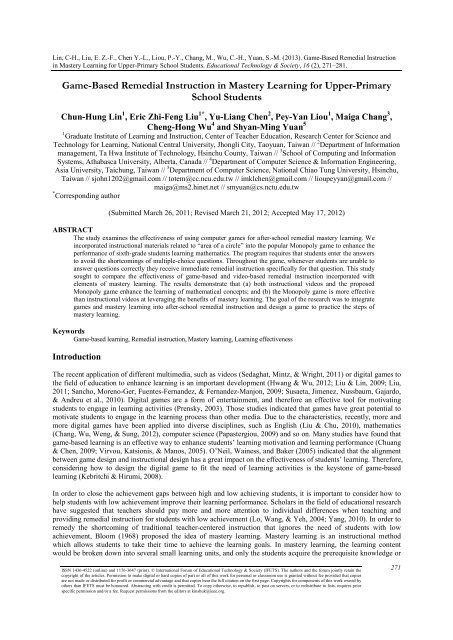Download Complete Issue in PDF - Educational Technology & Society
Download Complete Issue in PDF - Educational Technology & Society
Download Complete Issue in PDF - Educational Technology & Society
You also want an ePaper? Increase the reach of your titles
YUMPU automatically turns print PDFs into web optimized ePapers that Google loves.
L<strong>in</strong>, C-H., Liu, E. Z.-F., Chen Y.-L., Liou, P.-Y., Chang, M., Wu, C.-H., Yuan, S.-M. (2013). Game-Based Remedial Instruction<br />
<strong>in</strong> Mastery Learn<strong>in</strong>g for Upper-Primary School Students. <strong>Educational</strong> <strong>Technology</strong> & <strong>Society</strong>, 16 (2), 271–281.<br />
Game-Based Remedial Instruction <strong>in</strong> Mastery Learn<strong>in</strong>g for Upper-Primary<br />
School Students<br />
Chun-Hung L<strong>in</strong> 1 , Eric Zhi-Feng Liu 1* , Yu-Liang Chen 2 , Pey-Yan Liou 1 , Maiga Chang 3 ,<br />
Cheng-Hong Wu 4 and Shyan-M<strong>in</strong>g Yuan 5<br />
1 Graduate Institute of Learn<strong>in</strong>g and Instruction, Center of Teacher Education, Research Center for Science and<br />
<strong>Technology</strong> for Learn<strong>in</strong>g, National Central University, Jhongli City, Taoyuan, Taiwan // 2 Department of Information<br />
management, Ta Hwa Institute of <strong>Technology</strong>, Hs<strong>in</strong>chu County, Taiwan // 3 School of Comput<strong>in</strong>g and Information<br />
Systems, Athabasca University, Alberta, Canada // 4 Department of Computer Science & Information Eng<strong>in</strong>eer<strong>in</strong>g,<br />
Asia University, Taichung, Taiwan // 5 Department of Computer Science, National Chiao Tung University, Hs<strong>in</strong>chu,<br />
Taiwan // sjohn1202@gmail.com // totem@cc.ncu.edu.tw // imklchen@gmail.com // lioupeyyan@gmail.com //<br />
maiga@ms2.h<strong>in</strong>et.net // smyuan@cs.nctu.edu.tw<br />
* Correspond<strong>in</strong>g author<br />
(Submitted March 26, 2011; Revised March 21, 2012; Accepted May 17, 2012)<br />
ABSTRACT<br />
The study exam<strong>in</strong>es the effectiveness of us<strong>in</strong>g computer games for after-school remedial mastery learn<strong>in</strong>g. We<br />
<strong>in</strong>corporated <strong>in</strong>structional materials related to “area of a circle” <strong>in</strong>to the popular Monopoly game to enhance the<br />
performance of sixth-grade students learn<strong>in</strong>g mathematics. The program requires that students enter the answers<br />
to avoid the shortcom<strong>in</strong>gs of multiple-choice questions. Throughout the game, whenever students are unable to<br />
answer questions correctly they receive immediate remedial <strong>in</strong>struction specifically for that question. This study<br />
sought to compare the effectiveness of game-based and video-based remedial <strong>in</strong>struction <strong>in</strong>corporated with<br />
elements of mastery learn<strong>in</strong>g. The results demonstrate that (a) both <strong>in</strong>structional videos and the proposed<br />
Monopoly game enhance the learn<strong>in</strong>g of mathematical concepts; and (b) the Monopoly game is more effective<br />
than <strong>in</strong>structional videos at leverag<strong>in</strong>g the benefits of mastery learn<strong>in</strong>g. The goal of the research was to <strong>in</strong>tegrate<br />
games and mastery learn<strong>in</strong>g <strong>in</strong>to after-school remedial <strong>in</strong>struction and design a game to practice the steps of<br />
mastery learn<strong>in</strong>g.<br />
Keywords<br />
Game-based learn<strong>in</strong>g, Remedial <strong>in</strong>struction, Mastery learn<strong>in</strong>g, Learn<strong>in</strong>g effectiveness<br />
Introduction<br />
The recent application of different multimedia, such as videos (Sedaghat, M<strong>in</strong>tz, & Wright, 2011) or digital games to<br />
the field of education to enhance learn<strong>in</strong>g is an important development (Hwang & Wu, 2012; Liu & L<strong>in</strong>, 2009; Liu,<br />
2011; Sancho, Moreno-Ger, Fuentes-Fernandez, & Fernandez-Manjon, 2009; Susaeta, Jimenez, Nussbaum, Gajardo,<br />
& Andreu et al., 2010). Digital games are a form of enterta<strong>in</strong>ment, and therefore an effective tool for motivat<strong>in</strong>g<br />
students to engage <strong>in</strong> learn<strong>in</strong>g activities (Prensky, 2003). Those studies <strong>in</strong>dicated that games have great potential to<br />
motivate students to engage <strong>in</strong> the learn<strong>in</strong>g process than other media. Due to the characteristics, recently, more and<br />
more digital games have been applied <strong>in</strong>to diverse discipl<strong>in</strong>es, such as English (Liu & Chu, 2010), mathematics<br />
(Chang, Wu, Weng, & Sung, 2012), computer science (Papastergiou, 2009) and so on. Many studies have found that<br />
game-based learn<strong>in</strong>g is an effective way to enhance students’ learn<strong>in</strong>g motivation and learn<strong>in</strong>g performance (Chuang<br />
& Chen, 2009; Virvou, Katsionis, & Manos, 2005). O’Neil, Wa<strong>in</strong>ess, and Baker (2005) <strong>in</strong>dicated that the alignment<br />
between game design and <strong>in</strong>structional design has a great impact on the effectiveness of students’ learn<strong>in</strong>g. Therefore,<br />
consider<strong>in</strong>g how to design the digital game to fit the need of learn<strong>in</strong>g activities is the keystone of game-based<br />
learn<strong>in</strong>g (Kebritchi & Hirumi, 2008).<br />
In order to close the achievement gaps between high and low achiev<strong>in</strong>g students, it is important to consider how to<br />
help students with low achievement improve their learn<strong>in</strong>g performance. Scholars <strong>in</strong> the field of educational research<br />
have suggested that teachers should pay more and more attention to <strong>in</strong>dividual differences when teach<strong>in</strong>g and<br />
provid<strong>in</strong>g remedial <strong>in</strong>struction for students with low achievement (Lo, Wang, & Yeh, 2004; Yang, 2010). In order to<br />
remedy the shortcom<strong>in</strong>g of traditional teacher-centered <strong>in</strong>struction that ignores the need of students with low<br />
achievement, Bloom (1968) proposed the idea of mastery learn<strong>in</strong>g. Mastery learn<strong>in</strong>g is an <strong>in</strong>structional method<br />
which allows students to take their time to achieve the learn<strong>in</strong>g goals. In mastery learn<strong>in</strong>g, the learn<strong>in</strong>g content<br />
would be broken down <strong>in</strong>to several small learn<strong>in</strong>g units, and only the students acquire the prerequisite knowledge or<br />
ISSN 1436-4522 (onl<strong>in</strong>e) and 1176-3647 (pr<strong>in</strong>t). © International Forum of <strong>Educational</strong> <strong>Technology</strong> & <strong>Society</strong> (IFETS). The authors and the forum jo<strong>in</strong>tly reta<strong>in</strong> the<br />
copyright of the articles. Permission to make digital or hard copies of part or all of this work for personal or classroom use is granted without fee provided that copies<br />
are not made or distributed for profit or commercial advantage and that copies bear the full citation on the first page. Copyrights for components of this work owned by<br />
others than IFETS must be honoured. Abstract<strong>in</strong>g with credit is permitted. To copy otherwise, to republish, to post on servers, or to redistribute to lists, requires prior<br />
specific permission and/or a fee. Request permissions from the editors at k<strong>in</strong>shuk@ieee.org.<br />
271

















